Llanbedr is a village in the ancient county of Merionethshire, which is situated on the A496 main road, some three miles south of Harlech. To the west of the village is the old RAF airfield, which was used for many used by the Royal Aircraft Establishment, and later Qinetiq, for the flying of aerial targets for the missile range at Aberporth, further down the coast. Just off the east of the main road, on the road to Cwm Bychan, is the village war memorial, which is enclosed within a memorial garden, and commemorates the fallen of both World Wars. There is also an individual memorial to Corporal Barney Warburton of the Royal Engineers, who was killed in Bosnia. Also within the memorial garden is a tablet commemorating the men and women who trained at RAF Llanbedr, during World War Two, which was moved here from Maes Artro in 2011.
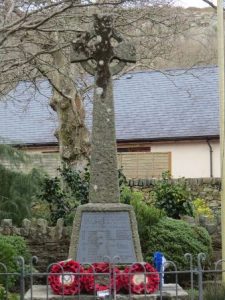
The Great War, 1914-1918
Trevor Rhys Allaway, MC, Captain, Welsh Regiment. Trevor was born at Cheltenham on 5 July 1891, the son of Captain William Rhys Powell Allaway and Gwladis Mary Bullock Allaway (nee Webster). The family had a home at Artro House, Llanbedr. Trevor was educated at Cheltenham and trained as a Solicitor. He was articled to W. T Carless, of Hereford before gaining a commission into the 3rd Battalion, South Wales Borderers on 6 January 1912. Following the outbreak of war, he disembarked at France on 9 October 1914 and was attached to the 2nd Battalion, Welsh Regiment, which was at Ypres attached to 3 Brigade, 1st Division. The 2nd Welsh was at Ypres, and Trevor arrived to battalion HQ on 3 November, while the battalion was under heavy shellfire. During heavy fighting on 22 December Trevor distinguished himself by shooting a German officer and driving out a machine gun single-handed, and then recovering 100 yards of trench, and was mentioned in despatches and promoted to Captain. He was the awarded the Military Cross for distinguished service in the field, before being posted to the Army School of Instruction at Zeitoun, Egypt. On 29 June 1916, just a week after his MC award was published, he was badly injured during an accident whilst at the grenade training school at Zeitoun and died that same day. Trevor was 24 years old and is buried in Cairo War Memorial Cemetery, Egypt.
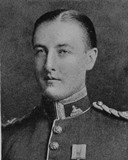
John Evans, Private, 35110, Welsh Regiment. John was the son of William Evans and Catherine Evans (nee Edwards), of Glanartw Cottage, Llanbedr. He worked as a collier at Ystradfodwg prior to enlisting at Treorchy into the Welsh Regiment under the name of John Edwards. After completing his training, he was posted to France early in 1916, joining the 13th Battalion, Welsh Regiment. The battalion was raised in the Rhondda and was attached to 114 Brigade, 38th (Welsh) Division. The division had been in France since 2 December 1915 and trained in the Nursery Sector near Fleurbaix before moving to Cuinchy and saw action there before being moved south to the Somme in June 1916, to take part in the assault on Mametz Wood. The first attack was sent in on 7 July, but failed after suffering heavy casualties, and the Divisional Commander, Sir Ivor Philipps was replaced before the Division assaulted the wood again on 10 July 1916. John was killed at some time during the day. The 32-year-old has no known grave and is commemorated on the Thiepval Memorial, France. His brother, John Ivor Evans, also fell. (John is incorrectly commemorated under his alias of John Edwards by the CWGC, hence his name is wrong on the Thiepval Memorial).
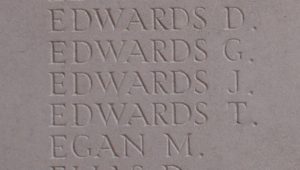
John Ivor Evans, Private, 54027, Welsh Regiment. John was the son of William Evans, of Glanartw Cottage, Llanbedr. He worked as a drapers assistant at Porth prior to enlisting at Treorchy into the Welsh Regiment, as had his brother. John was posted to France in the summer of 1916, joining the 14th Battalion, Welsh Regiment. The battalion had been raised in Swansea before landing in France on 4 December 1915 as part of 114 Brigade, 38th (Welsh) Division. He probably joined the battalion after the Division had been withdrawn from the Somme and had taken over the line along the Canal Bank, north of Ypres. On 1 December 1916 the 14th Welsh was in reserve behind the Canal Bank, and the men were being kept busy on working parties. On the following day John was sent out with one such working party to carry out improvements on Atlas Trench, but the men came under fire, and John and three other men were wounded, whilst their Sergeant was killed. John was evacuated to the hospital at Hazebrouck where he died of his wounds four days later, on 6 December 1916, aged 35. He is buried in Hazebrouck Communal Cemetery, France. His brother, John, had been killed earlier that year.
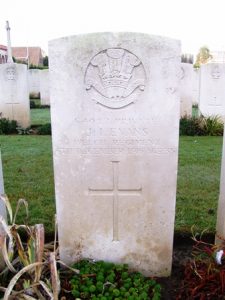
Rhys Roberts Humphreys, Air Mechanic 2nd Class, 109537, Royal Flying Corps. Rhys was born on 4 April 1897, the son of John Evans Humpreys and Elizabeth Humphreys, of Gwynfryn, Llanbedr. He was studying at Oxford when war broke out, and had served with the Officer Training Corps. He was commissioned as a Second Lieutenant into the Welsh Regiment on 30 August 1915 and served for twelve months before being discharged and re-enlisted at Armoury House into the Honourable Artillery Company on 20 October 1916. He served in France from 10 October 1916 until 22 December 1916 before returning to England to be discharged to a commission into the Royal Naval Air Service. He joined the RNAS on 8 April 1917 and was posted to Crystal Palace for training, before joining the RNAS Airship Depot at Wormwood Scrubbs, but went AWOL and was discharged from the RNAS as a result. He then joined the Royal Flying Corps, and was posted to the 35th Training Squadron to train as a pilot. On 15 March 1918, Rhys was undertaking flying instruction aboard a Bristol F.2b, Serial C4647, with Captain Edward Fraser Norris, and was carrying out loops, when the wings folded and the aircraft crashed into the ground at Port Meadow Aerodrome, Oxford, killing both men. Rhys was 21 years old and his remains were brought home for burial in Nazareth Calvinistic Methodist Cemetery, Penrhyndeudraeth.
William Herbert Jones, Private, 541449, Royal Army Service Corps. William was the son of Rees and Laura Jones, of Glan’Rafon, Llanbedr. He had served during the war with the Royal Army Service Corps. William survived the war, coming home to Llanbedr, but his health had been affected by his service and he died of pleuro pneumonia at Llanbedr on 14 February 1919, aged 22. He was buried in Moriah Chapelyard, Llanbedr. William is not commemorated by the CWGC.
Arthur Wynne Jones, Private, 114776, Canadian Infantry. Arthur was born on 16 July 1893, the son of William and Jane Jones, of Port Dinorwic. His mother was from Llanbedr and the family often stayed with her parents in the village. Following the death of his father in 1910, Arthur emigrated to Canada, to join his older brother Wyn, and found work as a steam fitter. His mother was by then living at Min-y-Don, Pwllheli. He enlisted at Swift Current, Saskatchewan on 22 December 1914 into the 9th Overseas Canadian Mounted Rifle Regiment and arrived in England on 3 December 1915. On 20 January 1916 Arthur arrived in France, joining the 1st Canadian Mounted Rifles, which was in positions near Ypres, at Mount Sorrel. Arthur was shot in the head here on 7 June 1916 and was evacuated to the No 13 General Hospital at Boulogne, before being transferred back to England, to St. Bartholomew’s Hospital, London. Some five months later he was transferred to the Duchess of Connaught’s Red Cross Hospital, near Taplow, where he began to suffer epileptic fits as a result of his head wound. Now seriously ill, Arthur was transferred to Lord Derby’s War Hospital at Warrington, where he died following another epileptic seizure on 21 May 1917, aged 22. His remains were brought home for burial in St. Mary’s Churchyard, Llanfair-Is-Gaer. Arthur is not commemorated at Llanbedr, but is named on the Pwlhelli War Memorial. His brother Wyn was killed a year later.
Wyn Rowland Rhys Jones, Lieutenant, 1010048, Canadian Infantry. Wyn was born on 26 July 1881, the son of William and Jane Jones, of Port Dinorwic. His mother was from Llanbedr and the family often stayed with her parents in the village. Wyn emigrated to Canada prior to the war and worked as an accountant at Moose Jaw, where he had married Elizabeth Cringan on 20 October 1909. He enlisted into the 229th Overseas Battalion, Canadian Infantry at Camp Hughes, Manitoba on 20 August 1916, and was soon commissioned as a Lieutenant. On 16 April 1917 he was posted to England, so brought his wife and two young children with him. Wyn went to Salisbury Plain with the Canadians, while his family went to live with his mother, who was by then widowed. Wyn was then posted to France on 5 November 1917, joining the 46th Battalion, Canadian Infantry. The battalion was attached to the 10th Brigade, 4th Canadian Division, and was known as the ‘Suicide Battalion’, having suffered terrible casualties at the Somme the previous year and at Passchendaele. The Canadian Corps had a relatively quiet time after the closure of the Passchendaele offensive, and in July 1918 Wyn returned to his family for two weeks leave. He returned to France on 3 August, just prior to the Battle of Amiens, the action which changed the course of the war. On 8 August 1918 a combined offensive by the Australians, alongside the Canadian Corps, backed up by Cavalry, was launched to the east of Amiens, along the line of the river Somme, towards Péronne, and saw the German line smashed. By 11.00 the advance had moved forwards some three miles, destroying German morale in doing so. The offensive continued over the coming days, and at dawn on 10 August 1918 Wyn assembled with his battalion at the edge of the Rouvroy to Vrelly Road, ready to launch another advance. Wyn and two other officers were killed following the capture of the battalion’s objectives that day. He was 37 years old and is buried in Fouquescourt British Cemetery, France. Wyn does not appear to be commemorated locally. His brother Arthur had died of wounds the previous year.
Iolo Mabon Lewis, Corporal, 291109, Royal Welsh Fusiliers. Iolo was the son of Edward and Jane Lewis, of Bryn Hyfryd, Llanbedr. He had enlisted at Newtown into the 3/7th Battalion, Royal Welsh Fusiliers on 26 June 1915 and remained on home service for over a year. Iolo married Martha Louisa Riches, a domestic servant from London, in 1916. Martha had worked for Lord Glanusk at Brecon before finding a position at Aber Atro Hall prior to the war. On 11 December 1916 he embarked at Southampton for Egypt to join the 1/7th Battalion, Royal Welsh Fusiliers, which was attached to the 53rd (Welsh) Division. The Division was near the Suez Canal, as part of the EEF, preparing to launch its offensive into Palestine. Iolo arrived in Egypt safely on 26 December and joined the battalion five days later. He was almost immediately promoted to Corporal, then to Acting Sergeant. The coastal city of Gaza was to the north of the canal, and was the centre for the Turkish defensive position in Palestine. On 26 March 1917 the First Battle of Gaza was launched and the 53rd (Welsh) Division was among the attacking forces, attacking the Gaza positions from the south. The day ended in chaos for the EEF, and most of the ground gained was later ceded back to the Turks. Among the many casualties suffered during the days fighting was Iolo. He was 27 years old and is buried in Gaza War Cemetery, Israel.
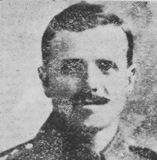
Matthew Owen Lloyd, Pioneer, WR/43758, Royal Engineers. Matthew was the son of William and Catherine Lloyd, of Gellirwaen, Llanbedr. He worked as a collier at the United National Colliery at Watstown prior to enlisting at Wrexham into the Royal Engineers on 2 March 1916, joining the Army Reserve. On 26 July 1918 he was mobilised and was posted to the Road and Quarry Troops Depot, RE at Bordon for training, but by the time he was ready to join a unit, the war had ended. He suffered from ill health even from the time of enlistment, and was discharged from the army. He returned home to Llanbedr where he died of tuberculosis on 1 February 1919, aged 33. Matthew is buried in Salem Baptist Chapelyard, Llanbedr. His brother, William, also died during the war.
Thomas Lloyd, Private, 265677, Royal Welsh Fusiliers. Thomas was the son of Thomas and Catherine Lloyd, of Minffordd Horeb, Dyffryn Ardudwy. He worked as a Draper prior to the war, and had lived at Llanbedr and then at Neath by 1911. Thomas had served with the 3rd Volunteer Battalion, Royal Welsh Fusiliers during the Boer War. He re-enlisted into the 6th Battalion, Royal Welsh Fusiliers at Carnarvon on 3 October 1914, giving his address as 14, Stanley Crescent, Holyhead. He served at home with the 2/6th Battalion, RWF until embarking at Devonport with the 1/6th Battalion, RWF on 14 July 1915. The battalion was attached to the 53rd (Welsh) Division and landed at Suvla Bay, Gallipoli on 8 August 1915. Thomas survived the carnage of the landings, but by October had become ill and was admitted to the 2nd Welsh Field Ambulance after contracting dysentery and jaundice. He was then evacuated to the 17th General Hospital, Alexandria before returning to England on 8 December 1915 aboard the Hospital Ship Essequibo. It was over a year before Thomas had recovered enough to return to duty and on 12 January 1917 he embarked at Devonport for Alexandria, joining the 1/5th Battalion, Royal Welsh Fusiliers, which was on the Suez Canal with the 53rd (Welsh) Division. The coastal city of Gaza was to the north of the canal, and was the centre for the Turkish defensive position in Palestine. On 26 March 1917 the First Battle of Gaza was launched and the 53rd (Welsh) Division was among the attacking forces, attacking the Gaza positions from the south. The day ended in chaos for the EEF, and most of the ground gained was later ceded back to the Turks. Thomas was posted as wounded and missing during the day, but was never seen again, so is officially recorded as having been killed in action on that day, 26 March 1917, aged 42. He has no known grave and is commemorated on the Jerusalem Memorial, Israel. Thomas is also commemorated on the Dyffryn Ardudwy War Memorial.
William Lloyd, Private, 4343, Royal Welsh Fusiliers. William was the son of William and Catherine Lloyd, of Gellirwaen, Llanbedr. He worked as a grocer’s assistant prior to enlisting into the 7th Battalion, Royal Welsh Fusiliers. William was obviously not fit for front line duties, as he was posted to the 3/7th Battalion, Royal Welsh Fusiliers, which was on home service at Prees Heath. William became ill and died at Prees Heath Military Hospital due to an intestinal obstruction on 28 March 1916, aged 29. His remains were brought home for burial in Salem Baptist Chapelyard, Llanbedr. His brother, Matthew, died in 1919 as a result of his military service.
Richard Owen, Private, 268071, Royal Welsh Fusiliers. Richard was the son of Richard and Margaret Owen, of Tynllidiart, Llanbedr. He worked as a farm labourer prior to enlisting at Dolgellau into the 5th Battalion, Royal Welsh Fusiliers on 9 September 1915. Richard remained on home service until being drafted to France, embarking on 14 March 1918, and was posted from the Base Depot to the 9th Battalion, Royal Welsh Fusiliers, joining the remnants of the battalion on 29 March. The battalion was attached to 58 Brigade, 19th (Western) Division which had been badly hit following the German Spring offensive on the Somme a week earlier. The Division was withdrawn from the Somme and moved to a more peaceful section of the line near Messines Ridge to rest and rebuild, but on 9 April the Germans launched the second phase of their offensive along the Lys valley, and the 19th Division became caught up in terrible fighting again, before being withdrawn and moved to the Aisne. Again, it was unfortunate, as the third and last phase of the German offensive was launched on the Aisne on 27 May and the Division was again caught up in heavy fighting. The tide of war turned following the combined Australian/ Canadian victory at Villers-Bretonneux from 8 August and on 21 August 1918 the Allies launched their great offensive all along the Western Front. The 19th Division advanced in Northern France and from 4 November took part in the final battle of the war, the Battle of the Sambre. Richard was killed in action on 6 November 1918, during the capture of the village of Bettrechies, east of Valenciennes. The 20-year-old has no known grave and is commemorated on the Vis-en-Artois Memorial, Haucourt, France. His brother Robert also fell. Both men are also commemorated on the nearby Llanfair War Memorial.
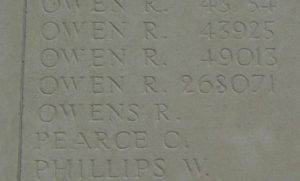
Robert Owen, Private, 15251, Royal Welsh Fusiliers. Robert was the son of Richard and Margaret Owen, of Tynllidiart, Llanbedr. He worked as a farm labourer prior to enlisting at Dolgellau into the 10th Battalion, Royal Welsh Fusiliers. The battalion was originally formed in Wrexham and moved to Codford St. Mary, Salisbury Plain attached to 76 Brigade, 25th Division. On 27 September 1915 Robert landed at Boulogne with the battalion, before 76 Brigade transferred to the 3rd Division at Ypres. By 4 October 1915 the 10th Battalion, RWF had reached its barracks at Bailleul and six days later marched to Poperinghe, coming under command of the 3rd Division, and on 15 October took over trenches in the Ypres Salient for the first time. On 27 November 1915 the battalion was once again in the firing line, when Robert was shot in the head and killed by a German sniper. One of the battalion snipers managed to shoot and kill the German just afterwards. Robert was just 19 years old when he was killed that day and is buried in Hedge Row Trench Cemetery, Belgium. His brother Richard also fell. Both men are also commemorated on the nearby Llanfair War Memorial.
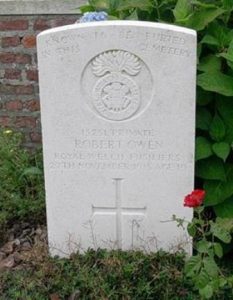
John Richards, Private, 2785, Royal Welsh Fusiliers. John was the son of Richard and Catherine Richards, of Railway Crossing, Llanbedr. He enlisted at Newtown into the 1/7th Battalion, Royal Welsh Fusiliers. The battalion mobilised at Montgomery on 4 August 1914 as part of North Wales Brigade, Welsh Division. The Division moved to Bedford in May 1915 where it was reorganised, becoming 158 Brigade, 53rd (Welsh) Division, and on 19 July 1915 sailed from Devonport for Imbros, before landing at Suvla Bay on 9 August 1915. The Division advanced inland, but was hindered by a lack of knowledge of the terrain and poor maps, so the advance soon turned into chaos. John was killed in action on the following day, 10 August 1915, aged 21. He has no known grave and is commemorated on the Helles Memorial, Gallipoli. He is also commemorated on the war memorial at Dyffryn Ardudwy.
John Richards, Gunner, 113044, Royal Garrison Artillery. John was the son of John and Emily Richards, of Bronafon, Llanbedr. He worked as a shoemaker prior to enlisting into the Royal Garrison Artillery at Dolgellau on 7 August 1915. He served at home until 20 December 1916, when he embarked for France to join the 216th Siege Battery, Royal Garrison Artillery. The 216th Siege Battery consisted of four 6″ howitzers, which together with their crews formed a part of the 46th (North Midland) Division. The 46th Division had fought through some of the toughest campaigns of the Great War. It took a leading part in the opening of the Battle of the Somme in July 1916, and fought through the Battles of the Ancre, the German retreat to the Hindenburg Line in 1917, and through to the Battle for Hill 70. On 12 August 1917, John’s battery was in action, preparing for the forthcoming Battle for Hill 70, when he was wounded by German counter-artillery fire. John died later that same day, on 12 August 1917, aged 26. He is buried in Maroc British Cemetery, Grenay, France. A number of his former comrades, including a man from my home of Laugharne, were killed in the coming days, and all are buried in a row together.
Patrick Houston Shaw-Stewart, Lieutenant Commander, Royal Naval Volunteer Reserve. Patrick was born at Aber Artro, Llanbedr on 17 August 1888, the son of Major General John Heron Maxwell Shaw-Stewart and Mary Catherine Bedingfield Shaw-Stewart (nee Collyer). He was educated at Eton and at Balliol College, Oxford, where he became well known for his intellect. He accepted a position with Barings Bank upon leaving Oxford and by 1913 was a managing director. Patrick was very well known in London, being part of the infamous ‘coterie’, which included such contemporaries as Lady Diana Manners, Raymond Asquith and Nancy Cunard. He was on a business trip in America when war was declared and upon his return was commissioned as Sub-Lieutenant into the Royal Naval Volunteer Reserve in September 1914, joining Hood Battalion, Royal Naval Division. He embarked aboard the SS Grantully Castle with Hood Battalion on 22 February 1915, among a group of officers which included FS Kelly, Bernard Freyberg, and Rupert Brooke. Following Brooke’s untimely death, Patrick led the firing party during his burial on the Isle of Skyros on 23 April 1915. Two days later he landed on the shores of Gallipoli with the Royal Naval Division. After the evacuation of Gallipoli, where his friend Freyburg had won the Victoria Cross, Patrick spent time in Salonika, where he was attached to the French forces, and was awarded the Croix de Guerre. He then requested permission to re-join Hood Battalion in May 1917 and became its temporary commanding officer. Patrick was killed in action during the Battle of Cambrai on 30 December 1917, aged 29. He is buried in Metz-en-Couture Communal Cemetery, British Extension, France. After his death he became known as a ‘War Poet’, following the publication of his poem ‘Achilles in the Trench’. Patrick is not commemorated at Llanbedr.

Robert Thomas, Private, 81005, Royal Welsh Fusiliers. Robert was the son of John and Ellen Thomas, of Ty Isaf, Gwynfryn, Llanbedr. He worked as a carter on a farm prior to the war. Robert enlisted at Barmouth into the Royal Welsh Fusiliers and after training was posted to France, joining the 2nd Battalion, Royal Welsh Fusiliers. The battalion had been in France since 11 August 1914 and had become attached to 19 Brigade. The Brigade had been attached to various Divisions since then: on 12 October 1914 to the 6th Division; on 31 May 1915 to the 27th Division; on 19 August 1915 to the 2nd Division; and from 25 November 1915 to the 33rd Division, which had recently landed in France. The Division saw its first major action during the Battle of the Somme, from July 1916 onwards. During the following year it fought at the Battle of the Scarpe and at Bullecourt, before heading north to take part in the Third Battle of Ypres. The 2nd RWR, and the remainder of 19 Brigade, trained for the offensive at Moule from 31 August 1917 until 15 September when the Brigade marched out of camp to Wulverdinghe. Over the next few days the Brigade moved closer to the front line and on 25 September 1917 moved into position facing Polygon Wood, ready to launch an attack on the following morning. Orders were received by the Brigade at 08.15 to move forwards and the attacking battalions advanced through Glencorse Wood past Black Watch Corner and formed a line. Zero hour was 12.00 noon, and the men arose from their positions, coming under heavy machine-gun and artillery fire. Robert was one of many casualties suffered by the 2nd RWF during the day, 26 September 1917. The 28-year-old has no known grave and is commemorated on the Tyne Cot Memorial, Belgium. Robert is also commemorated on the Barmouth War Memorial.
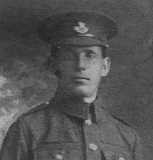
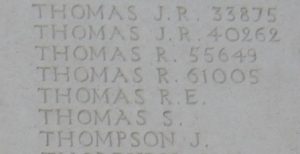
William Jones Williams, Lance Sergeant, 290560, Royal Welsh Fusiliers. William was the son of Edward and Mary Williams, of Tan-y-Wenallt, Llanbedr. He enlisted at Harlech into the 7th Battalion, Royal Welsh Fusiliers on 12 August 1914. The battalion assembled at Newtown as part of North Wales Brigade, Welsh Division, moving to Conway until end of August then to Northampton. During May 1915 the Division moved to Bedford where the formation became 158 Brigade, 53rd (Welsh) Division and on 19 July 1915 the entire Division sailed from Devonport for Imbros. On 9 August 1915 the Division landed at Suvla Bay, Gallipoli and remained on the peninsula until being evacuated to Egypt in December 1915. The Division became part of the EEF and helped drive the Turks out of Sinai, securing the Suez Canal before launching the first offensive into Palestine on 26 March 1917, at the First Battle of Gaza. The battle was shambolic and a second attempt to force Gaza also failed the following month. The Third Battle of Gaza was more successful. Three divisions assaulted Gaza, fooling the Turks into believing that the Allies intended to try the same plan again, while the real attack was made towards Beersheba. Beersheba fell on 31 October 1917, allowing the EEF to attack Gaza from two sides. William was killed in action during this assault on Gaza from positions north of Beersheba, on 6 November 1917, aged 23. He is buried in Beersheba War Cemetery, Israel.
World War Two, 1939-1945
Tom Chadwick, Flight Sergeant, 534411, Royal Air Force. Tom was the son of Walter and Jane Chadwick, of Heywood, Lancashire. He lived at Glyn Dwr, Llanbedr prior to the war. He enlisted into the Royal Air Force and trained as a pilot before being posted to 53 Squadron, RAF, which was a Coastal Command Squadron, based at RAF St Eval, in Cornwall. The squadron operated the Consolidated B-24 Liberator and flew anti-submarine and anti-shipping patrols off the south coast and into the Bay of Biscay. On 18 July 1943 Tom took off from St Eval aboard Liberator BZ731, on an anti-submarine patrol in the Bay of Biscay. The aircraft failed to return on the following morning. Tom and the other six crewmen of the Liberator are officially recorded as having died on 19 July 1943. Tom was 29 years old when he went missing that day and is commemorated on the Runnymede Memorial, Surrey.
Richard Llewelyn Jones, Fusilier, 14387099, Royal Welch Fusiliers. Richard was born on 24 March 1924, the son of Evan and Mary Catherine Jones, of Gellibant, Llanbedr. He enlisted into the Royal Welch Fusiliers and was posted to the 2nd Battalion, Royal Welch Fusiliers. The battalion was in Burma with the 36th Division, taking part in the campaign to drive the Japanese out of the former British colony. The Division took part in the Arakan Operations in 1944, in support of the 5th Indian Division in the Jungle around the Ngayadauk Pass and the Mayu Tunnels. In May 1944 it was withdrawn from the Arakan Front and after a short rest joined General J. Stillwell’s American- Chinese Forces and took part in hard fighting around Myitkyina and Mogaung, where the Division took over from the remains of the Chindits. Richard died in Burma on 29 November 1944, aged 20. He is buried in Taukkyan War Cemetery, Myanmar.
Robert Pugh Jones, Fusilier, 4209261, Royal Welch Fusiliers. Robert was the son of William and Mary Jones, of Bryn Moel, Llanbedr. He enlisted into the 7th Battalion, Royal Welch Fusiliers. The battalion was attached to the 53rd (Welsh) Division and spent much of the war on home service before landing in Normandy with the Division at the end of June 1944. Following heavy fighting in Normandy, the Division took part in the advance through northern France into Belgium and Holland, fighting in Operation Market Garden and during the Battle of the Bulge. By January 1945 the Battle of the Bulge was over, and the Allies could once again concentrate on the offensive to push into Germany. During the coming weeks, the 53rd Division crossed the River Maas and took part in heavy fighting around the Reichswald Forest, opening the way for the Rhine crossing. By the middle of March the Allies had closed up to the Rhine and on 7 March the Americans had captured the Remagen bridge. The crossing of the Rhine was codenamed ‘Operation Plunder’ and on 23 March 1945 the 53rd Division was moved from its rest area in Brussels to positions around Kevelaer, where it received its orders. The Rhine was crossed on 25 March and within the coming days the 53rd Division assembled north of Wesel. Robert was killed soon after, during the capture of Dingden, on 28 March 1945, aged 24. He is buried in Reichswald Forest War Cemetery, Germany.
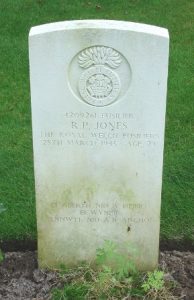
T. R. Jones, Sergeant. Of Morfa Mawr. This man cannot presently be identified.
Peter Turner Lawson, Pilot Officer, 47162, Royal Air Force. Peter was the son of Joseph Frank Lawson, and of Mary Turner Lawson (nee Cooper), of Tynwern, Llanbedr. He enlisted into the Royal Air Force and trained as a Navigator prior to being posted to 89 Squadron, Royal Air Force. The squadron reformed on 25 September 1941 at RAF Colerne, equipped with Bristol Beaufighter night fighters and embarked for Egypt, to defend the Nile delta and the Suez Canal. On 27 September 1942, Peter took off from RAF Charib in Egypt aboard Bristol Beaufighter Mk IF, Serial X7700, flown by Wing Commander Stainforth, the Squadron CO, which had been detailed for a defensive patrol. The aircraft suffered an engine failure and crashed a mile west of Charib, killing Peter and his CO. Peter was 22 years old when he was killed in the crash, and is buried in Ismailia War Memorial Cemetery, Egypt.
Arthur Capel Stringer, Leading Airman, FAA/FX. 80081, Royal Navy. Arthur was born on 16 October 1921, the son of Francis and Constance Stringer, of Craig Artro, Llanbedr. He enlisted into the Royal Navy and after training was posted to HMS Goshawk. On 15 January 1941 Arthur sailed from Liverpool aboard the SS Almeda Star, among a large number of men of the Fleet Air Arm, destined for Argentina. While passing through the Western Approaches on 17 January 1941, Almeda Star was spotted by the German submarine U-96, which fired a torpedo at the liner, striking her amidships. The stricken ship ground to a halt and the U-Boat fired two more torpedoes at her, before opening fire with her deck gun, and Almeda Star sank with the loss of all 360 people aboard her. Arthur was just 19 years old when he died that day and is commemorated on the Lee-on-Solent Memorial, Hampshire.
Bosnian War, 1992-1995
Barney Dylan Warburton, Corporal, 24658649, Royal Engineers. Barney was born on 4 December 1966, the son of Harry Warburton and Blodwen Thomas Warburton (nee Griffith). The family lived in Llys Brithyll, Llanbedr. Barney enlisted into the Royal Engineers and after training in bomb disposal was based at Carver Barracks, Wimbish, Saffron Walden. On 6 April 1992 war erupted in the former Yugoslavia. The war had begun as a result of Slovenia and Croatia declaring independence from Yugoslavia, when the residents of Bosnia and Herzegovina began to disagree about doing the same. The Serbs wished to remain part of the country, whilst the Bosniaks and Croats wished for independence. The war was a bloody one, with many war crimes being committed, so in 1994 NATO first became involved, sending in a peacekeeping force, UNPROFOR, and carrying out air strikes on strategic targets. Barney was posted to Bosnia with the NATO task force, UNPROFOR, during the Bosnian War. He was unfortunately killed whilst clearing mines near the football stadium at Stari Vitez, Bosnia on 19 March 1994, aged 27. The area had been ethnically cleansed by the Croatians earlier in the war. His body was brought home for burial in St. Peter’s Churchyard, Llanbedr. The continual NATO air strikes had failed to bring the war to an end, so NATO despatched a task force in 1995, code-named ‘Operation Deliberate Force’, to target the positions of the Army of the Republika Srpska. Eventually the work carried out by NATO led to peace, and the negotiations to end the war were finalised at Dayton, Ohio on 21 November 1995.
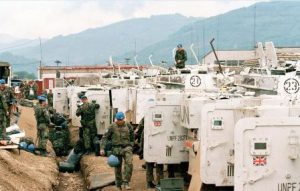
(c) NATO